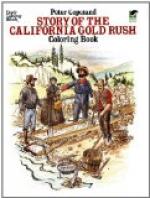Then a great machine called a “header and thresher” is driven into the field and sweeps through miles and miles of bending grain, cutting swaths as wide as a street, and harvesting, threshing, and leaving a long trail of sacked wheat ready to ship on the cars. Thirty-six horses draw the header, and five or six men are needed to attend to this giant, who bites off the grain, shakes out the kernels, throws them into sacks and sews them up, all in one breath, as you might say. The harvesters work from daylight to dusk, and three-fourths of our wheat crop is gathered in this way.
Much golden straw is left, besides that which the “headers” burn as fuel, and farmers stack this straw for cattle to nibble at. The stock feed in the stubble fields, too, and strange visitors also come to these ranches to pick up the scattered grains of wheat. These strangers are wild white geese, in such large flocks that when feeding they look like snow patches on the ground. They eat so much that often they cannot fly and may be knocked over with clubs. In the spring these geese must be driven away by watchmen with shot-guns to keep them from pulling up the young grain.
The largest single wheat-field in California is on the banks of the San Joaquin River, in Madera County. This covers twenty-five thousand acres and is almost as flat as a floor. It is nearly a perfect square in shape, and each side of the square is a little over six miles long. There are no roads through this solid stretch of grain. Two hundred men, a thousand horses, and many big machines are needed to work this wheat-field.
Some of the big harvesters that cut and thresh the wheat are drawn by a traction-engine instead of horses. In running a fifty-horse-power engine high-priced coal had to be burnt but now the coal grates are replaced by petroleum burners, and crude coal-oil is the cheap fuel. This does not make sparks to set the fields on fire like burning coal or straw and so is safer to use.
On large ranches wheat can be grown for less than a cent a pound, while it has brought two cents or double the money when sold. But there are not always good crops, as the grain needs plenty of moisture in the spring when rains are uncertain.
The wheat crop of the state has fallen off of late to less than half the yield of earlier years, but the deep, rich valley soil still grows grain enough to feed hungry people in Europe, Asia, and Africa, as well as in our own Union. Great quantities are taken in large four-masted ships to Liverpool, England, and there made into American flour. Our own flour-mills turn out thousands of barrels of flour, and this travels far, too. The first thing picked up in Manila after Admiral Dewey’s victory was a flour sack with a California mill mark.
It would need a long, long story to tell how far from home and into what strange places the yellow kernels of California wheat sometimes travel, or to picture the odd people who depend upon us for food.




